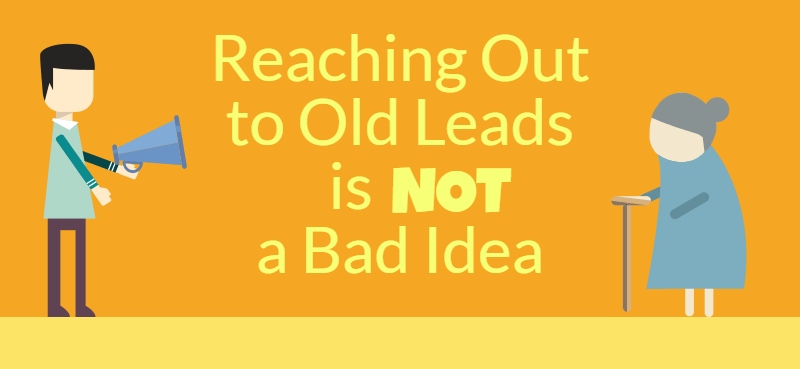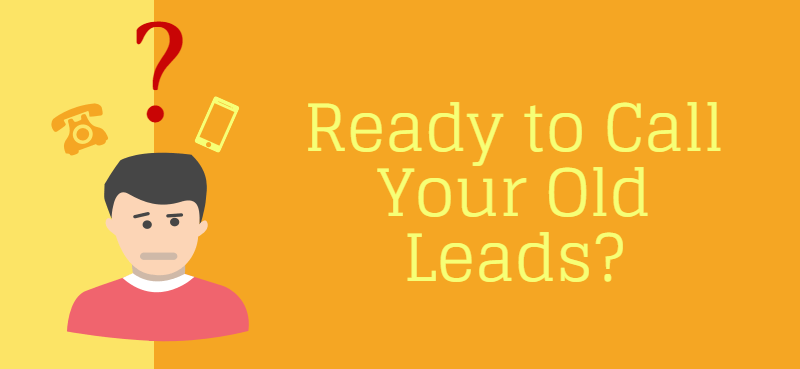When you re-engage old leads it can bring so many advantages to your sales. Enjoy the benefits if you get to pique the interest of your old leads again!
4 Benefits of Re-engaging Old Leads
1 Re-fill your sales pipeline
Unless you’ve been using targeted lead gathering techniques for a while, there’s a good chance you have thousands of old leads that have been all but forgotten.
Like a field that’s grown over and full of rocks, it may seem like nothing will ever grow.
They are the hundreds and hundreds of people who didn’t answer, told you to shove off, or even went a decent way through the process before calling it quits.
Most sales folks just want to forget about these lost contacts and move onto a different field ready to sow.
That would be a mistake.
Meeting your quota is difficult without multiple ways of finding deals. One of those tricks that help is to reengage old leads. So, grab a cup of coffee (or any beverage really) along with those contacts you never thought you’d look at again.

“It is the time you have wasted for your rose that makes your rose so important.” ― Antoine de Saint-Exupéry
That’s no way to build your business or make your revenue targets.
If you’ve read any of our posts, you’ll know that we love looking at who we’ll be pitching before we reach out.
Limiting prospects to those that would become our ideal buyers and those who fit into a few indicators based on industry, employee size, roles (decision-makers), etc.
This does take work, but it’s so much nicer than sending impersonal b2b re-engagement emails to a thousand contacts you know nothing about.
It’s the work you put into your list that makes even those who passed (or didn’t respond) worth reaching out to…again.
You’ve wasted a lot of time on that rose, and it’s time to see it come open.
But we’re not asking you to just reach out to old leads in vain, but in the full knowledge that you’ll get sales. Enough to make doing it something you’ll want to add to your standard procedures.
2 Save your budget
If you’re currently paying for fresh leads, generating revenue from people in your database can save you cash. Whe you re-engage old leads, on the other hand, it’s about more than just saving money.

If you get successful as to re-engage old leads, the customer will buy from you faster than the new ones will. This implies that not only are you saving funds on marketing costs, but you’re also saving time that could be spent finding new prospects by re-activating an old lead.
3 Increase your sales
When you get to re-engage old leads, it will not only make be easier for you but re-activating them is a great way of building customer loyalty. 
Loyal customers are your best customers; re-activating an old one means that they probably liked what you have offered to them before so re-engaging could be a way of rekindling their support.
4 Improve your database accuracy
If the old leads you have taking up spots in your database are old and outdated, they can bounce and lead to major email servers viewing your emails as spam.
Discovering that these addresses are no longer valid dead leads and removing them will help cut down on the number of emails that bounce and improve the accuracy of your data collection.

Keeping an eye on the database that you have and making use of them to re-engage old leads is a way of de-cluttering, getting rid of old addresses, and making room for new ones.
This will give you more space as well as make it easier to sort through contacts when they become relevant again.
Avoid the Wrong Way to Re-engage Old Leads

One of the worst things that can happen (as a result of this post) is for you to not take these leads seriously.
There are wrong ways to re-engage old leads though.
It’s ok to move forward skeptically by doing a test run of a few hundred leads, but don’t do it at all if you’re not going to put the same care (or more) into these leads the second go around as you did the first time you approached them.
To help, we’ll give you a few of the most common mistakes to avoid if you want to re-engage old leads.
1 Being Too Casual
Everyone has a strategy when reaching out to leads. Maybe you reach out on LinkedIn first. Or send a cold email. Maybe even (rarely) pick up the phone and go in guns blazing. Don’t do something silly like comment on one of their social posts asking for a connection.
2 Taking the Past for Granted
Just because they may have talked to you before doesn’t mean you can treat your re-outreach less professionally. An entire conversation is ruined with a, “I told you that six months ago.” In fact, bring up your previous conversation may cause them to remember why they liked your product.
3 Waiting Too Long to Get to the Point
Yes, there is an intro phase to this, but it’s not a long-term thing. You don’t have to like all their LI posts for another month before getting down to brass tacks. Get their attention—tell them why you got their attention—ask them for the sale.
How to Re-engage Old Leads in 4 Steps

1 Research Before You Start
Before you just open up the CRM and start blasting out the same cold emails, you should do some prep. To be honest, just sending out emails again could work. That said, a little strategy could yield better results.
Here are a few ways to do it:
-
Keep Your Eyes Peeled
Take a look at any triggers and activity your leads have been up to. For instance, you’re a CPA. Look for any finance-related posts on social, maybe even an executive reaching out for similar services to yours. Any indication of interest would be a great sign that this isn’t a dead lead.
-
Try to Remember
Obviously, you talk to a lot of people. Every day you’re on the phone, sending emails, and interacting via chat or social. You won’t remember everything. Although, you may have a decent CRM and have put notes about your interactions. These can be golden to remembering and renegotiating.
-
Be Personal
Again, don’t send out an automated email (unless the leads didn’t have any contact besides email before). For those leads that you actually interacted with, you have a relationship. This means that you have to be a bit more personal. Try to search for a sample email to old customers that can help you. Re-engagement email subject lines are also important, so make sure that you think about it hard before you type.
2 Start With a “Feeler”
Just like you don’t want to do a hard pitch in your “we miss you emails” in the first go, you don’t want to just blurt out that you’re trying to take care of unfinished business this time around. Just blurting out something like, “I was wondering if you were ready to think about switching?”.

Here are a couple of things to help.
-
Send Content
If you look in your CRM and find out that said lead was interested in something. Why not find a great new resource about that subject and send it their way? Better yet, if a lot of leads share the interest, create a better resource and let everyone know about it.
-
Invite Them
Send out a semi-personalized email inviting old leads only (for tracking) to join you on a webinar about [insert common industry subject here]. There’s usually a sample letter to reconnect with clients on the web today so utilize them. Track open rates, sign-up rates, and those who show up. Doing so will help you figure out if it’s worthwhile (may not be for everyone).
-
Give Them Value
Have a valuable link (via your blog)? Ask them for a guest post. Have a podcast? Make them a guest. Put together a survey and allow them to take part and promise to send them the results when you’re done. Do something for them without expecting a return. (This tip works on the first outreach, too).
3 Discuss What’s Changed with Them
It’s been at least six months since you’ve exchanged emails (or calls). Change is guaranteed and constant in life and people love to talk about themselves (mostly).
Why not put these two things together?
Ask them softball question(s) (mostly business related) in a quick email that could elicit a response. Find the best reconnect email sample template to help you. You could also pick up the phone (if you feel that’s the best way to get a hold of them) and ask about them. But be sure to bring your listening ears to the get-together.
Listen for things like:
-
Needs expressed (that you can solve)
-
Frustrations (with their current solution)
-
Demeanor (are they irritated you’ve called back?)
“And that is how change happens. One gesture. One person. One moment at a time.” ― Libba Bray Share on X
4 Discuss What’s Changed with You (Well, the Product)
The opposite side of the change coin is you (actually, what you sell).
If your lead seems to be open to conversation, take a breath and start talking about you a bit.
Maybe say something like, “Well, [product/service] has had a lot of improvements since you last gave it a look.”, and then move into what’s different. Just make some good win back email subject lines and let them engage to sell your product.
-
New Features
Different things your products do can go a long way toward moving old leads into a decision. It not only shows you’re more valuable now but that you could become more valuable over time. This is very important to include when writing a letter to reconnect with old clients.
-
Discounts
If you’re running a special, it’s a great time to pull out those dusty leads. If pricing was the biggest issue before, it could be a very quick “yes”. Still go through the re engaging steps, but get here as soon as you can.
-
New Processes
Sometimes people want to buy through a link on a sales page, others want to talk with a rep. Then, there are some who may want to watch a pre-recorded demo and buy at the end. If you’ve added a way to buy, it could draw in prospects to make the decision.
Ready to Call Your Old Leads?

Of course, once you go through these steps, you’re going to have to ask for the sale. Or, at least if they want to have another demo, trial, or sales call.
The end of the process is going to vary based on your current sales process.
At a point in which you recognize the old lead has been revived and you can ask for the close, you’ll want to run them through your closing process—because they’ve probably not been there before.
Conclusion
The question is, did we convince you to re-engage your old leads? Hurray if the answer is yes! Go ahead, send out your win back email campaigns, and let your business take advantage of the benefits as you reconnect with them again.
Want to help contribute to future articles? Have data-backed and tactical advice to share? I’d love to hear from you!
We have over 60,000 monthly readers that would love to see it! Contact us and let's discuss your ideas!


